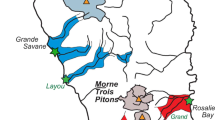Abstract.
We introduce a novel scheme that enables natural silicic glasses to be projected into the synthetic system Qz–Ab–Or–H2O in order to relate variations in volcanic glass chemistry to changing pressure (P) and temperature (T) conditions in the sub-volcanic magma system. By this means an important distinction can be made between ascent-driven and cooling-driven crystallisation under water-saturated or undersaturated conditions. In samples containing feldspar and a silica phase (quartz or tridymite), quantitative P–T estimates of the conditions of last equilibrium between crystals and melt can be made. Formation of highly silicic melts (i.e. >77 wt% SiO2) is a simple consequence of the contraction of the silica phase volume with decreasing pressure, such that high silica glasses can only form by crystallisation at low pressure. Resorption of quartz crystals appears to be a further diagnostic feature of decompression crystallisation. Groundmass and inclusion glasses in dacites from the 1980–1986 eruption of Mount St Helens volcano (WA) span a wide range in SiO2 (68–80 wt%, anhydrous). The compositions of the least evolved (SiO2-poor) inclusions in amphibole phenocrysts record entrapment of silicic liquids with ≤5.4 wt% water, corresponding to a water saturation pressure of ~200 MPa at 900 °C. The compositions of more evolved (higher SiO2) plagioclase-hosted inclusions and groundmass glasses are consistent with extensive ascent-driven fractional crystallisation of plagioclase, oxide and orthopyroxene phenocrysts and microlites to low pressures. During this polybaric crystallisation, plagioclase phenocrysts trapped melts with a wide range of dissolved water contents (3.5–5.7 wt%). Magmas erupted during the Plinian phase of the 18 May 1980 eruption were derived from a large reservoir at depths of ≥6 km. Subsequent magmas ascended to varying depths within the sub-volcanic system prior to extraction. From glass chemistry and groundmass texture two arrest levels have been identified, at depths of 0.5–1 and 2–4 km. A single dome sample from February 1983 contains groundmass plagioclase, tridymite and quartz, testifying to temperatures of at least 885 °C at 11 MPa. These shallow storage conditions are comparable to those in the cryptodome formed during spring 1980. The corresponding thermal gradient, ≤0.2 °C MPa–1, is consistent with near-adiabatic magma ascent from ~8 km. We argue that the crystallisation history of Mount St Helens dacite magma was largely a consequence of decompression crystallisation of hot magma beyond the point of water saturation. This challenges the conventional view that phenocryst crystallisation occurred by cooling in a large magma chamber prior to the 1980–1986 eruption. Because the crystallisation process is both polybaric and fractional, it cannot be simulated directly using isobaric equilibrium crystallisation experiments. However, calculation of the phase proportions in water-saturated 910±15 °C experiments by Rutherford et al. (1985) over the pressure range 220–125 MPa reproduces the crystallisation sequence and phenocryst modes of Mount St Helens dacites from 18 May 1980. By allowing for the effects of fractional versus equilibrium crystallisation, entrained residual source material, and small temperature differences between nature and experiment, phase compositions can also be matched to the natural samples. We conclude that decompression of water-saturated magma may be the dominant driving force for crystallisation at many other silicic volcanic centres.
Similar content being viewed by others
Author information
Authors and Affiliations
Additional information
Electronic Publication
Rights and permissions
About this article
Cite this article
Blundy, J., Cashman, K. Ascent-driven crystallisation of dacite magmas at Mount St Helens, 1980–1986. Contrib Mineral Petrol 140, 631–650 (2001). https://doi.org/10.1007/s004100000219
Received:
Accepted:
Published:
Issue Date:
DOI: https://doi.org/10.1007/s004100000219




